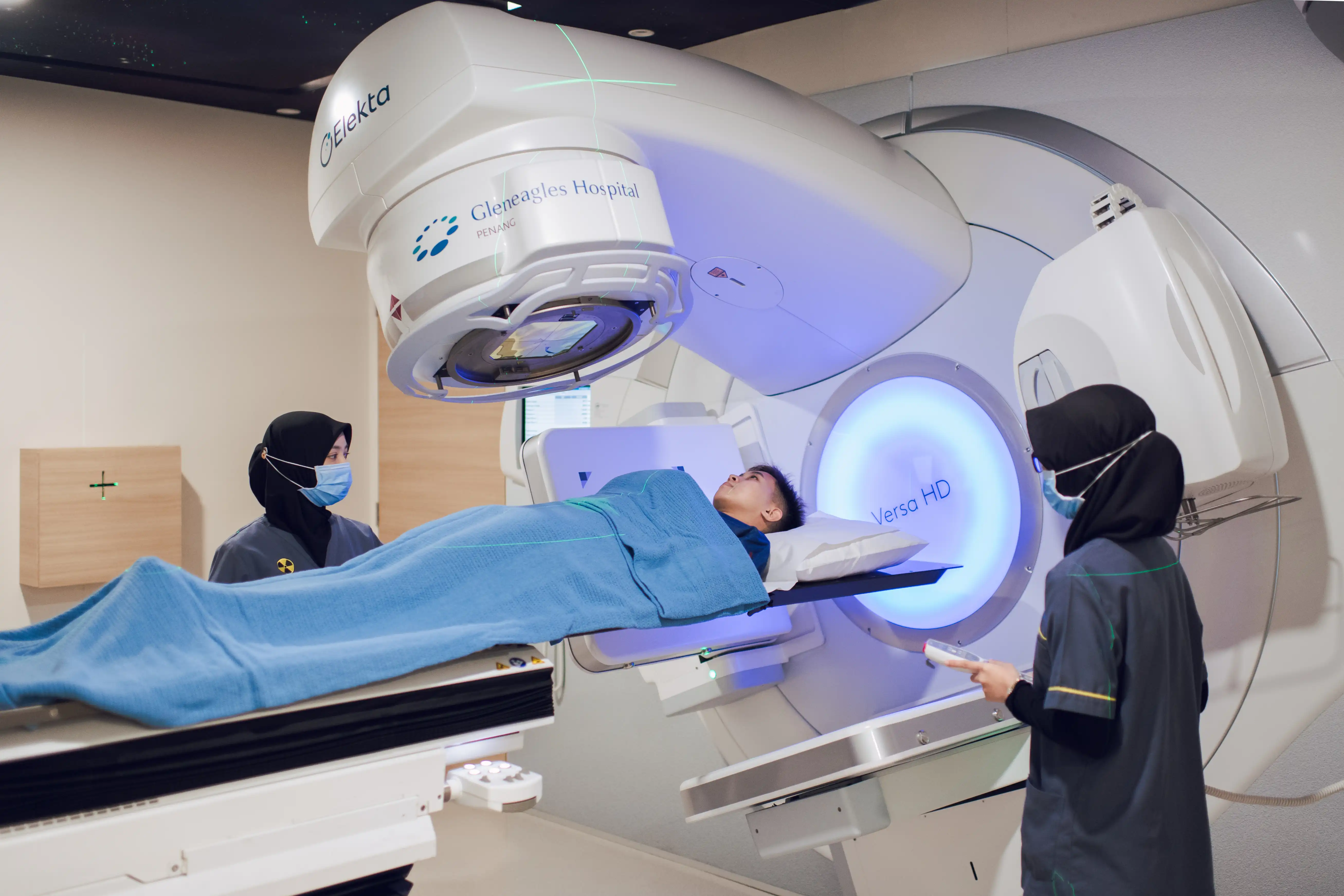The ovaries are part of the female reproductive system. They are two almond-shaped organs that are on each side of
the uterus.
The ovaries have two primary functions:
- As part of the menstrual cycle, to release an egg every 28 days, approximately.
- To release oestrogen and progesterone, which are essential for reproduction.

Fluid-filled sacs that develop on or in the ovary are known as ovarian cysts. An ovarian cyst may affect only one
ovary or both simultaneously. They are prevalent in women of all ages and are usually asymptomatic (no symptoms).
The majority of ovarian cysts occur naturally and resolve within a few months without therapy. Cysts can range from
less than one centimetre (half an inch) to over 10 cm (4 inches).
Types of ovarian cysts
Functional cysts
This is the most common type of ovarian cyst and is linked to the menstrual cycle. They usually do not
cause any symptoms and do not require treatment.
Functional cysts are non-cancerous (benign) and often harmless. They may, however, occasionally cause
symptoms such as pelvic pain.
Pathological cysts
Pathological cysts are unrelated to the menstrual cycle and are caused by abnormal cell growth. They can
develop prior to and after menopause.
Pathological cysts originate from either the cells responsible for the production of the ovum or the cells
that line the outer surface of the ovary. They may occasionally burst or grow extensively, obstructing the blood
supply to the ovaries.
Most pathological cysts are benign (non-cancerous), but a small percentage are malignant (cancerous) and
may need to be removed surgically.
Ovarian cysts symptoms
Most ovarian cysts are asymptomatic except if it ruptures, are large and block the blood supply to ovaries.
Some symptoms include:
- Pelvic pain – dull, heavy, sudden, or sharp pain
- Difficulty emptying bowels
- Pain during sexual intercourse
- Delayed, irregular or unusually painful periods
- Bloating and swelling of the abdomen
- Frequent urination
- Feeling full after eating minimal food
- Difficulty getting pregnant
Causes of ovarian cysts
The most common causes of ovarian cysts are determined by whether an individual is premenopausal (still
menstruating) or postmenopausal (stopped menstruating for at least a year).
For premenopausal women
- Polycystic ovarian disease (PCOS): Many small and harmless cysts develop on your ovaries. The
cysts are small follicles that do not mature to ovulation and are due to altered hormone levels.
- Endometriosis: The lining of the uterus (endometrium) is present outside the uterus in the
ovaries, fallopian tubes, vagina, intestine, bladder, or rectum. At times, blood-filled cysts may form in this
tissue.
- Pregnancy: During early pregnancy, an ovarian cyst typically develops to support the pregnancy
until the placenta forms. In certain instances, the cyst remains on the ovary until the latter stages of
pregnancy.
- Severe pelvic infections: Pus-filled cysts form near the ovaries or/and fallopian tubes.
- Non-cancerous growth
- Cancer
For postmenopausal women
- Non-cancerous growth
- Fluid collection in the ovary
New growth is more likely to be caused by cancer compared to premenopausal women.
Ovarian cysts risk factors
The following risk factors put you at a higher risk of developing ovarian cysts:
- Infertility treatment – ovulation induction by gonadotropins or other agents
- Pregnancy – may form in the second trimester when the hCG levels peak
- Hypothyroidism
- Smoking
- Tubal ligation
- Maternal gonadotropins
Ovarian cysts complications
The outcomes of ovarian cysts can vary widely. The cyst is usually non-cancerous and asymptomatic;
therefore, no treatment is required, and it will resolve independently.
However, in some cases, complications can occur. Complications include:
- Torsion: Large-sized cysts can cause the ovaries to move and twist, which can be very painful
- Rupture: Occasionally, the cyst can rupture and cause heavy bleeding
Ovarian cysts diagnosis
Diagnosis is made based on various investigations. Your doctor would first question your general health,
symptoms and conduct a thorough physical examination.
- Imaging tests such as ultrasound, computed tomography (CT) scan or magnetic resonance imaging
(MRI) are performed to provide information on the cyst size, location, and other characteristics.
- Blood test such as cancer antigen 125 (CA 125) is often recommended for postmenopausal women
with an ovarian cyst, premenopausal women with a larger ovarian cyst or suspicious of cancer.
Treatment for ovarian cysts
Most ovarian cysts do not require treatment. Ovarian cysts in premenopausal women typically resolve within one to two months without treatment, whereas it is less likely to resolve in postmenopausal women.
If a cyst is large, painful or appears suspicious of cancer, the cyst or the entire ovary is typically surgically removed.
Watchful waiting
For premenopausal women:
- Monitoring symptoms such as pelvic pain or pressure
- Repeat pelvic ultrasound 6-8 weeks
- If cyst size remains the same or decreases in size, ultrasound is repeated at regular intervals
- No further testing or follow-up is required if the cyst resolves
For postmenopausal women:
- Based on the results of the initial diagnostic tests (ultrasound and CA 125)
- Watchful waiting may be an option if the cyst does not appear to be cancerous
- Ultrasound and CA 125 are to be repeated every 3-6 months for a year or until the cyst resolves
- However, ovarian cysts may not always resolve in women who have reached menopause
- Surgical removal of the cyst may be advised if the CA 125 levels increase or if the cyst grows or changes in appearance
Surgery
Surgery is recommended if:
- A cyst causes prolonged pain or pressure, or it could rupture or twist
- Cyst is caused by endometriosis
- Large cysts (>5cm to 10 cm) compared to smaller cysts. However, the size of a cyst does not determine the nature of the cyst (cancerous or non-cancerous)
- If the cyst is suspected of cancer, the whole ovary has to be removed
If the likelihood of ovarian cancer is low, but the cyst does not resolve after multiple ultrasounds, you may decide to have it removed after consulting with your doctor. Nevertheless, surgical removal is usually not recommended in this instance.
Types of surgeries include laparoscopy (keyhole, minimally invasive surgery) and laparotomy (open incision). Laparotomy is performed if the cyst is particularly large or if it could be cancerous
FAQ on ovarian cysts
Does spicy food cause ovarian cysts?
No. There is no direct scientific correlation between ovarian cysts and the consumption of spicy food.
What type of diet is recommended for women with ovarian cysts?
It is recommended to consume a high-fibre, low-fat diet. Additionally, foods that have anti-inflammatory properties may help.
What are the chances of getting pregnant with ovarian cysts?
It depends on the cause of the ovarian cyst. Most individuals with cysts can become pregnant.
Read more: Fibroids vs Cysts
Book an appointment at Gleneagles Hospitals
Are you concerned about the risk factors of ovarian cysts? Get in touch with us to book an appointment with an O&G specialist at Gleneagles Hospitals today. We assure you the best possible care tailored to your specific needs.











-yeoh-chee-lima51b01d7-09b0-4e11-a0a5-ce3c9ea5de79.jpg?sfvrsn=615d491f_6)

